Basics of Design
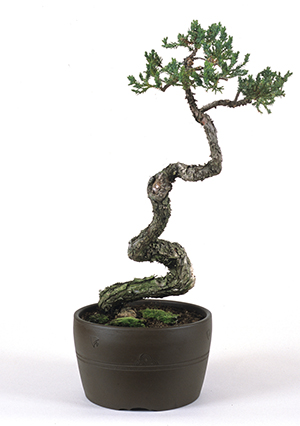
Bonsai Design Introduction
by Lew Buller
There are enough different bonsai designs and names to confuse all but the experts. I intend to discuss the five basic designs at some length, and to the extent I have trees that show other designs, provide examples and their names. The five basic designs are formal upright, informal upright, slant style, half-cascade, and cascade.
If a few of the trees here seem familiar you may have seen them in Saikei and Art.
Basics of Design

Cascade Forms
by Lew Buller
Kengai is the Japanese word for cascade. Han-kengai is the word for half-cascade. In John Naka’s Bonsai Techniques I, he discusses various forms of cascades and illustrates them with drawings. Kengai, the regular cascade, drops about 450 but not in a straight line; the tip swings either left or right.
Basics of Design
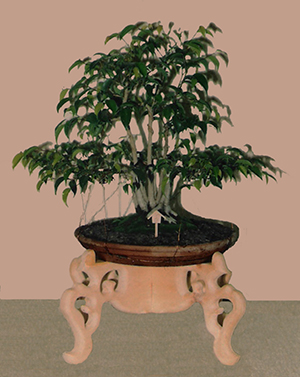
Clump
by Lew Buller
The members of the bonsai club liked bonsai with heavy trunks, often cutting the tops off larger trees to get a large trunk. I got the bright idea of planting a number of young trees close together, letting them approach graft one another, and creating a large trunk.
An added benefit was that I could bend the tops over and create branches at any height I wanted. “Clump” is the locally preferred term. When I got a copy of Naka’s Bonsai Techniques I, he called it “Sprout” style and illustrated several variations.
Ficus cuttings were easily available, so I stuck a handful of them together in a growing pot. Later, roots were trimmed and they went into a flat clay pot. I showed it at the club show on the beginners’ table.
Basics of Design
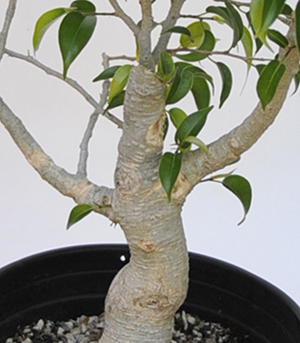
Computer Designs
by Lew Buller
Never could draw. When my bonsai instructors told me to draw a picture of the future tree I was working on, it came out like a kindergartner’s. I can, however, operate a computer mouse and a few basic skills have enabled me to use Photoshop to see what a future tree might look like.
Mostly I use cloning, either from one part of a photo to another, or from a copy saved before changes to the copy that I am making changes to.
Basics of Design
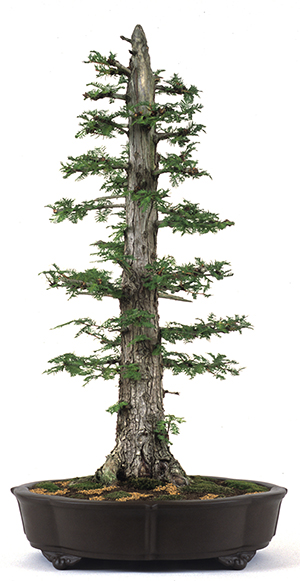
Formal Upright
by Lew Buller
There is only one formal upright in my collection, and that’s my bald cypress (Taxodium distichum). A formal upright requires a perfectly straight trunk and they are hard to come by. Even my bald cypress is not perfectly straight.
It grew in the ground for the first seven years of its life and could not be rotated to make sure all sides received the same amount of sun. The hormone auxin causes plants to bend toward the sun and so there is a slight bend in the bald cypress. To see the bend, you would have to see the tree from the side.
Wikipedia
In nature, the California redwoods (Sequoia sempervirens) are about as straight as you will find. The tallest, at 379 feet, appears to be perfectly straight. Apparently the biological mechanism causing the tree to grow tall to get more sunlight outweighs the effect of auxin that bends the tree toward the sun. (For the record, there is a Redwood bonsai in the Brooklyn Botanic Garden) The extreme example of plants seeking sun is the sunflower. It will have its face pointed toward the sun in the morning, turn to follow the sun all day, and end up facing the sun as it goes down.
There’s a message here. Rotate your bonsai no less than once a month and once a week is better unless there is an overriding reason not to do so. Having light growth on one side of the tree is a reason; leave that side of the tree facing the sun until growth evens out. Sun has a tremendous influence on plants and descriptions of plants in nurseries will give the plants’ requirements for sun. Plants will grow in darkness, but it causes etiolation, i. e., long internodes and an unhealthy color due to lack of chlorophyll.
Basics of Design
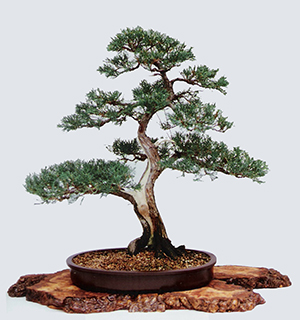
Informal Upright
by Lew Buller
There is only one formal upright in my collection, and that’s my bald cypress.
A formal upright requires a perfectly straight trunk and they are hard to come by. Consequently, most of my upright trees are of the informal style.
Basics of Design
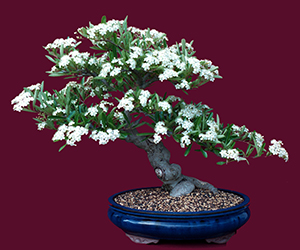
Slant Style (Shakan)
by Lew Buller
This firethorn (pyracantha) is my favorite slant style.
The Editor of Bonsai, Journal of the American Bonsai Society liked it as well. He made it on the cover photo of Spring 2003, Volume 37, Number 1. The only special design requirement it has it that it needs extra room between branches to let both blooms and berries grow.
